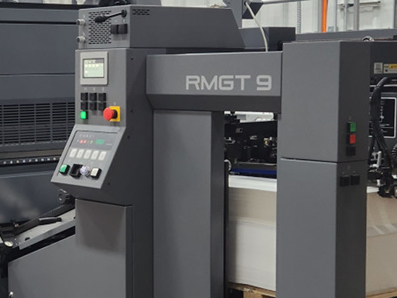
This article was written by Dan Marx and appeared in Printing Impressions on April 10, 2023. See the original publication here.
(The desire to automate and refine processes in sheetfed offset printing is driven by several factors, including the absence of qualified labor, reduction of touches, and efforts to minimize waste. In the past several years, press manufacturers have added and refined tools to make the sheetfed offset process much more efficient, and to achieve higher-quality, more repeatable results. This article continues our series of interviews with representatives from the leading sheetfed press manufacturers.)
“What’s driving innovation [today],” Kian Hemmen, western regional sales manager, print and finishing solutions, at RMGT, points out, “is the labor shortage … getting more done with less experienced operators.” Another driver is improved makeready: Companies are saving many hundreds of sheets during that activity. “Paper is still expensive,” he adds.
While there is not a great deal that is new in automation (as compared to, say, last year), awareness of these systems is increasing, according to Hemmen. “Many don’t know how far the automation has gone on these presses.” Part of what is needed to increase acceptance of automation is a deeper understanding of the true value of the systems. “They are not cheap,” he notes, “but if you can reduce a two-person press to a one-person press, you can have significant labor savings. It becomes a no-brainer.” Hemmen adds that general perception lags behind reality in terms of how well today’s automation systems work.
For RMGT sheetfed offset presses, Hemmen says that while many systems are pre-installed, other systems can be selected a-la-carte based on specific company needs. Popular optional choices include in-press color controls, and full-sheet inspection, which can identify imperfections as small as 0.3 millimeters — a level of detail and quality that enables a printer to enter the pharmaceutical printing space.
PSPs starting their sheetfed automation journey, according to Hemmen, can best do so by identifying their process pain points, then make plans to address them. “It’s really about identifying the need and understanding how far to take [the automation efforts]." He recommends visiting printers who have successfully addressed similar problems.
For those PSPs that truly embrace the benefits of automation systems, Hemmen says they can see a return on their investment in as little as nine months. For others, it can take as long as three years, based on utilization.
In the face of the profound effect of inflation on the printing industry, the importance of investing in and using automation within today’s sheetfed offset presses has become quite apparent. “The last five presses we’ve ordered have been equipped with every bell and whistle,” he notes. “Taking printing to the next level requires a whole spectrum of automation.” Software, a critical part of press automation and connectivity with other systems, is everywhere. Hemmen says that while many MIS and ERP systems are currently used across the sheetfed space, “most presses and front ends can be fully integrated.” There are a lot of tools on today’s presses, including those that relieve operators from having to manually enter job information, which can be integrated. He concludes that the company must have the wherewithal to use it.
